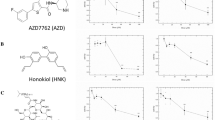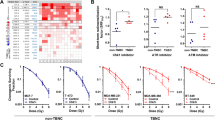Summary
Background and Purpose Trabectedin is a unique alkylating agent with promising effects against a range of solid tumors. In this study, we aimed to examine the cytotoxic and radiosensitizing effects of trabectedin on two human epithelial tumor cell lines in vitro, and its effects on DNA repair capacity. Methods Cancer cells (A549: human lung cancer cells, HT-29: colon cancer cells) were treated with either trabectedin alone for the determination of their growth, or in combination with radiation for the determination of their metabolic activity, proliferation, and clonogenic survival. Besides, the γH2AX foci assay was performed for the assessment of ionizing radiation-induced DNA damage and to evaluate the influence of trabectedin on DNA damage repair. Results Treatment with trabectedin resulted in a growth-inhibiting effect on both cell lines, with the IC50 values remaining within a low nanomolar range. Analyses of metabolic activity confirmed a cytotoxic influence of trabectedin and a BrdU assay demonstrated an antiproliferative effect. When combined with radiation, incubation with trabectedin was found to enhance the radiosensitivity of the tumor cells. The γH2AX foci assay resulted in an increased number of DNA double-strand breaks (DSBs) in cells treated with trabectedin. Conclusion The results of this study underline the antitumor activity of trabectedin at low nanomolar concentrations. We demonstrated that trabectedin enhanced radiation response in human lung (A549) cancer cells and colon (HT-29) cancer cells. Further studies are necessary to examine trabectedin as a potential candidate for future applications in radiotherapy.





Similar content being viewed by others
Data availability
The data supporting this study are provided in the results section of this paper. Further datasets used and/or analyzed during the current study are available are stored by the authors at the University Medical Center Rostock.
Abbreviations
- BrdU:
-
Bromodeoxyuridine
- DMEM:
-
Dulbecco’s modified Eagle medium
- DMSO:
-
Dimethylsulfoxide
- DSBs:
-
double strand breaks
- FBS:
-
fetal bovine serum
- HR:
-
homologous recombination
- IC50 :
-
drug concentration causing 50% growth inhibition
- ID50 :
-
radiation dose causing 50% inhibition of surviving fraction
- NSCLC:
-
non-small cell lung carcinoma
- SF4:
-
surviving fractions at 4 Gy
References
Tavecchio M, Simone M, Erba E, Chiolo I, Liberi G, Foiani M et al (2008) Role of homologous recombination in trabectedin-induced DNA damage. Eur J Cancer (Oxford, England 1990) 44(4):609–618
Cuevas C, Francesch A (2009) Development of Yondelis (trabectedin, ET-743). A semisynthetic process solves the supply problem. Nat Prod Rep 26(3):322–337
Allavena P, Germano G, Belgiovine C, D’Incalci M, Mantovani A (2013) Trabectedin: A drug from the sea that strikes tumor-associated macrophages. Oncoimmunology 2(6):e24614
Gomes NGM, Dasari R, Chandra S, Kiss R, Kornienko A (2016) Marine Invertebrate Metabolites with Anticancer Activities: Solutions to the “Supply Problem”. Mar Drugs 14(5)
Carter NJ, Keam SJ (2010) Trabectedin: a review of its use in soft tissue sarcoma and ovarian cancer. Drugs 70(3):355–376
EU clinical trials register. Clinical trials for yondelis. Available at https://www.clinicaltrialsregister.eu/ctr-search/search?query=yondelis. Accessed May 06, 2019
PharmaMarSA.Trabectedin(Yondelis ): summary of product characteristics online]. Available from URL: https://allthepowerofthesea.com/yondelis/yondelis-general-information: yondelis-epar-product-information_en.pdf (Accessed 2019 August 07) PharmaMarSA
Grisanti S, Cosentini D, Tovazzi V, Bianchi S, Lazzari B, Consoli F et al (2018) Hepatoprotective effect of N-acetylcysteine in trabectedin-induced liver toxicity in patients with advanced soft tissue sarcoma. Support Care Cancer 26(8):2929–2935
Jaeschke H, Gores GJ, Cederbaum AI, Hinson JA, Pessayre D, Lemasters JJ (2002) Mechanisms of hepatotoxicity. Toxicol Sci 65(2):166–176
Haeussler U, Riedel M, Keller F (2004) Free reactive oxygen species and nephrotoxicity of contrast agents. Kidney Blood Press Res 27(3):167–171
Cai Z, Lou Q, Wang F, Li E, Sun J, Fang H et al (2015) N-acetylcysteine protects against liver injure induced by carbon tetrachloride via activation of the Nrf2/HO-1 pathway. Int J Clin Exp Pathol 8(7):8655–8662
Donald S, Verschoyle RD, Greaves P, Orr S, Jimeno J, Gescher AJ (2004) Comparison of four modulators of drug metabolism as protectants against the hepatotoxicity of the novel antitumor drug yondelis (ET-743) in the female rat and in hepatocytes in vitro. Cancer Chemother Pharmacol 53(4):305–312
Grosso F, Dileo P, Sanfilippo R, Stacchiotti S, Bertulli R, Piovesan C et al (2006) Steroid premedication markedly reduces liver and bone marrow toxicity of trabectedin in advanced sarcoma. Eur J Cancer (Oxford, England 1990) 42(10):1484–1490
D’Incalci M, Galmarini CM (2010) A review of trabectedin (ET-743): a unique mechanism of action. Mol Cancer Ther 9(8):2157–2163
van Kesteren C, de VMMM, López-Lázaro L, Mathôt RAA, Schellens JHM, Jimeno JM et al (2003) Yondelis (trabectedin, ET-743): the development of an anticancer agent of marine origin. Anti-Cancer Drugs 14(7):487–502
Jimenez PC, Wilke DV, Costa-Lotufo LV (2018) Marine drugs for cancer: surfacing biotechnological innovations from the oceans. Clinics (Sao Paulo, Brazil) 73(suppl 1):e482s
Zewail-Foote M, Hurley LH (1999) Ecteinascidin 743: a minor groove alkylator that bends DNA toward the major groove. J Med Chem 42(14):2493–2497
Takebayashi Y, Pourquier P, Zimonjic DB, Nakayama K, Emmert S, Ueda T et al (2001) Antiproliferative activity of ecteinascidin 743 is dependent upon transcription-coupled nucleotide-excision repair. Nat Med 7(8):961–966
Erba E, Bergamaschi D, Bassano L, Damia G, Ronzoni S, Faircloth GT et al (2001) Ecteinascidin-743 (ET-743), a natural marine compound, with a unique mechanism of action. Eur J Cancer (Oxford, England 1990) 37(1):97–105
Simoens C, Korst AEC, de Pooter CMJ, Lambrechts HAJ, Pattyn GGO, Faircloth GT et al (2003) In vitro interaction between ecteinascidin 743 (ET-743) and radiation, in relation to its cell cycle effects. Br J Cancer 89(12):2305–2311
Martinez EJ, Corey EJ, Owa T (2001) Antitumor activity- and gene expression-based profiling of ecteinascidin Et 743 and phthalascidin Pt 650. Chem Biol 8(12):1151–1160
Romero J, Zapata I, Córdoba S, Jimeno JM, López-Martín JA, Tercero JC et al (2008) In vitro radiosensitisation by trabectedin in human cancer cell lines. Eur J Cancer (Oxford, England 1990) 44(12):1726–1733
Izbicka E, Lawrence R, Raymond E, Eckhardt G, Faircloth G, Jimeno J et al (1998) In vitro antitumor activity of the novel marine agent, ecteinascidin-743 (ET-743, NSC-648766) against human tumors explanted from patients. Ann Oncol (9):981–987
Ghielmini M, Colli E, Erba E, Bergamaschi D, Pampallona S, Jimeno J et al (1998) In vitro schedule-dependency of myelotoxicity and cytotoxicity of Ecteinascidin 743 (ET-743). Ann Oncol 9(9):989–993
Torre LA, Bray F, Siegel RL, Ferlay J, Lortet-Tieulent J, Jemal A (2015) Global cancer statistics, 2012. CA Cancer J Clin 65(2):87–108
Siegel RL, Miller KD, Jemal A (2017) Cancer statistics, 2017. CA Cancer J Clin 67(1):7–30
Joiner MC, van der Kogel AJ (2018) Basic clinical radiobiology, 5th edn. Chapman and Hall/CRC, London
European Medicines Agency Yondelis: EPAR – Summary for the public. Available at http://www.ema.europa.eu/docs/en_GB/document_library/EPAR_-_Summary_for_the_public/human/000773/WC500045833.pdf: Accessed, July 7, 2009
Taamma A, Misset JL, Riofrio M, Guzman C, Brain E, Lopez Lazaro L et al (2001) Phase I and pharmacokinetic study of ecteinascidin-743, a new marine compound, administered as a 24-hour continuous infusion in patients with solid tumors. J Clin Oncol Off J Am Soc Clin Oncol 19(5):1256–1265
Filek R, Hooper P, Sheidow TG, Liu H, Chakrabarti S, Hutnik CM (2019) Safety of anti-VEGF treatments in a diabetic rat model and retinal cell culture. Clin Ophthalmol (Auckland, NZ) 13:1097–1114
Patties I, Kortmann R-D, Glasow A (2013) Inhibitory effects of epigenetic modulators and differentiation inducers on human medulloblastoma cell lines. J Exp Clin Cancer Res 32:27
Xiong S, George S, Yu H, Damoiseaux R, France B, Ng KW et al (2013) Size influences the cytotoxicity of poly (lactic-co-glycolic acid) (PLGA) and titanium dioxide (TiO(2)) nanoparticles. Arch Toxicol 87(6):1075–1086
Berridge MV, Tan AS (1993) Characterization of the cellular reduction of 3-(4,5-dimethylthiazol-2-yl)-2,5-diphenyltetrazolium bromide (MTT): subcellular localization, substrate dependence, and involvement of mitochondrial electron transport in MTT reduction. Arch Biochem Biophys 303(2):474–482
Berridge MV, Herst PM, Tan AS (2005) Tetrazolium dyes as tools in cell biology: new insights into their cellular reduction. Biotechnol Annu Rev 11:127–152
Riss TL, Moravec RA, Niles AL, Duellman S, Benink HA, Worzella TJ et al (2004) Assay guidance manual: cell viability assays, Bethesda (MD
Blockhuys S, Vanhoecke B, Smet J, de PB, van Coster R, Bracke M et al (2013) Unraveling the mechanisms behind the enhanced MTT conversion by irradiated breast cancer cells. Radiat Res 179(4):433–443
Manda K, Kriesen S, Hildebrandt G, Fietkau R, Klautke G (2011) Omega-3 fatty acid supplementation in cancer therapy does eicosapentanoic acid influence the radiosensitivity of tumor cells? Strahlenther Onkol 187(2):127–134
Baumgart T, Klautke G, Kriesen S, Kuznetsov SA, Weiss DG, Fietkau R et al (2012) Radiosensitizing effect of epothilone B on human epithelial cancer cells. Strahlenther Onkol 188(2):177–184
Niero A, Emiliani E, Monti G, Pironi F, Turci L, Valenti AM et al (1999) Paclitaxel and radiotherapy: sequence-dependent efficacy—a preclinical model. Clin Cancer Res 5(8):2213–2222
Rogakou EP, Pilch DR, Orr AH, Ivanova VS, Bonner WM (1998) DNA double-stranded breaks induce histone H2AX phosphorylation on serine 139. J Biol Chem 273(10):5858–5868
Redon C, Pilch D, Rogakou E, Sedelnikova O, Newrock K, Bonner W (2002) Histone H2A variants H2AX and H2AZ. Curr Opin Genet Dev 12(2):162–169
Powell S, McMillan TJ (1990) DNA damage and repair following treatment with ionizing radiation. Radiother Oncol 19(2):95–108
Soares DG, Escargueil AE, Poindessous V, Sarasin A, de GA, Bonatto D et al (2007) Replication and homologous recombination repair regulate DNA double-strand break formation by the antitumor alkylator ecteinascidin 743. Proc Natl Acad Sci U S A 104(32):13062–13067
Casado JA, Río P, Marco E, García-Hernández V, Domingo A, Pérez L et al (2008) Relevance of the Fanconi anemia pathway in the response of human cells to trabectedin. Mol Cancer Ther 7(5):1309–1318
Funding
The research was performed as part of the employment of the authors by University Medical Center Rostock, Germany.
Author information
Authors and Affiliations
Contributions
K.M. designed the study. T.P. and T.S. performed experiments, as well as acquired and analyzed the data. S.K. developed the radiation setup und performed dosimetry. K.M. and T.P. wrote and drafted the manuscript. G.H. critically revised the manuscript and contributed to materials and tools. All authors read and approved the final manuscript.
Corresponding author
Ethics declarations
Conflict of interest
All authors declare that they have no conflicts of interest.
Ethical approval
This article does not contain any studies with human participants or animals performed by any of the authors.
Additional information
Publisher’s note
Springer Nature remains neutral with regard to jurisdictional claims in published maps and institutional affiliations.
Rights and permissions
About this article
Cite this article
Manda, K., Präkelt, T., Schröder, T. et al. Radiosensitizing effects of trabectedin on human A549 lung cancer cells and HT-29 colon cancer cells. Invest New Drugs 38, 967–976 (2020). https://doi.org/10.1007/s10637-019-00852-x
Received:
Accepted:
Published:
Issue Date:
DOI: https://doi.org/10.1007/s10637-019-00852-x




